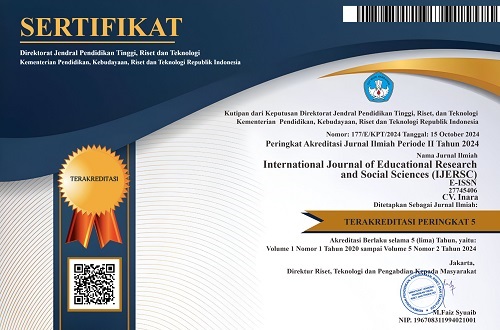How Can Gamification Help Language Learners? Insight From EFL Students And Teachers
DOI:
https://doi.org/10.51601/ijersc.v5i4.867Abstract
Gamification, integrating game elements in non-game environments, has garnered significant interest as an educational strategy. However, there is a need for more research focusing on its efficacy in learning English as a Foreign Language (EFL). This study aims to address this gap by exploring EFL students' learning experiences with gamification and synthesizing the factors that enhance language learning. In this study, four vocational school students and an EFL teacher participated in a classroom where gamification techniques were implemented for four consecutive weeks. To gather data, individual semi-structured interviews were conducted with the participants to gain insights into their perspectives. The data were then analyzed using thematic analysis. The findings of this study highlight the significant contributions of gamification in EFL learning by leading to better student engagement (behavioral, emotional, and cognitive), and providing immediate feedback and task level.
Keywords: gamification, language learning, EFL, educational strategy,
Downloads
References
Braun, V., & Clarke, V. (2006). Using thematic analysis in psychology. Qualitative Research in Psychology, 3(2), 77–101.
Brown, T. M. (2018). Playing to Win: Applying Cognitive Theory and Gamification to Augmented Reality for Enhanced Mathematical Outcomes in Underrepresented Student Populations.
Chen, Y. (2023). Integrating a Game-Based App to Enhance Translation Learners’ Engagement, Motivation, and Performance. International Journal of Instruction, 16(2), 759–782. https://doi.org/10.29333/iji.2023.16240a
Csikszentmihalyi, M. (2014). A theoretical model for enjoyment. In The Improvisation Studies Reader (pp. 150–162). Routledge.
Deterding, S., Sicart, M., Nacke, L., O’Hara, K., & Dixon, D. (2011). Gamification: Using Game Design Elements in Non-Gaming Contexts. Proceedings of the 2011 Annual Conference Extended Abstracts on Human Factors in Computing Systems.
Dihoff, R. E., Brosvic, G. M., Epstein, M. L., & Cook, M. J. (2004). Provision of feedback during preparation for academic testing: learning is enhanced bv immediate but not delaved feedback roberta e. dihoff. 1926, 207–231.
Ding, L. (2019). Applying gamifications to asynchronous online discussions: A mixed methods study. Computers in Human Behavior, 91, 1–11.
El Tantawi, M., Sadaf, S., & AlHumaid, J. (2018). Using gamification to develop academic writing skills in dental undergraduate students. European Journal of Dental Education, 22(1), 15–22.
Fredricks, J. A., Blumenfeld, P. C., & Paris, A. H. (2004). School engagement: Potential of the concept, state of the evidence. Review of Educational Research, 74(1), 59–109.
Fu, M., & Li, S. (2020). The effects of immediate and delayed corrective feedback on L2 development. Studies in Second Language Acquisition, 1–33. https://doi.org/10.1017/S0272263120000388
Handayani, P. W., Raharjo, S. R., & Putra, P. H. (2021). Active student learning through gamification in a learning management system. Electronic Journal of E-Learning, 19(6), 601–613.
Hsu, K. C. (2016). Social gamification in multimedia instruction: assessing the effects of animation, reward strategies, and social interactions on learners motivation and academic performance in online settings.
Huotari, K., & Hamari, J. (2012). Defining Gamification - A Service Marketing Perspective. Proceedings of the IADIS International Conference Interfaces and Human Computer Interaction 2012, IHCI 2012, Proceedings of the IADIS International Conference Game and Entertainment Technologies 2012, 227–231. https://doi.org/10.1145/2393132.2393137
Karl M. Kapp. (2012). The gamification of learning and instruction: Game-based methods and strategies for training and education. John Wiley & Sons.
Lee, J. J., & Hammer, J. (2011). Gamification in education: What, how, why bother? Academic Exchange Quarterly, 15(2), 146.
Marczewski, A. (2013). Gamification: a simple introduction.
Mayer, R. E., & Moreno, R. (2003). Nine Ways to Reduce Cognitive Load in Multimedia Learning Nine Ways to Reduce Cognitive Load in Multimedia Learning. Educational Psychologist, 38(1), 43–52. https://doi.org/10.1207/S15326985EP3801
Ozhan, S, C., & Kocadere, S. A. (2020). The Effects of Flow , Emotional Engagement , and Motivation on Success in a Gamified Online Learning Environment. Journal of Educational Computing Research, 57(8). https://doi.org/10.1177/0735633118823159
Peng, C. (2021). The Academic Motivation and Engagement of Students in English as a Foreign Language Classes: Does Teacher Praise Matter? Frontiers in Psychology, 12(October). https://doi.org/10.3389/fpsyg.2021.778174
Qiao, S., Yeung, S. S. sze, Zainuddin, Z., Ng, D. T. K., & Chu, S. K. W. (2022). Examining the effects of mixed and non-digital gamification on students’ learning performance, cognitive engagement and course satisfaction. British Journal of Educational Technology. https://doi.org/10.1111/bjet.13249
Thuy, N. T. T., & Hung, L. N. Q. (2021). Teachers’ perceptions of using gamification apps in teaching speaking skill to EFL young learners. International Journal of Science and Management Studies, 4(5).
Zhang, S., & Hasim, Z. (2023). Gamification in EFL/ESL instruction: A systematic review of empirical research. Frontiers in Psychology, 13.
Downloads
Published
How to Cite
Issue
Section
License
Copyright (c) 2024 International Journal of Educational Research & Social Sciences

This work is licensed under a Creative Commons Attribution 4.0 International License.






















